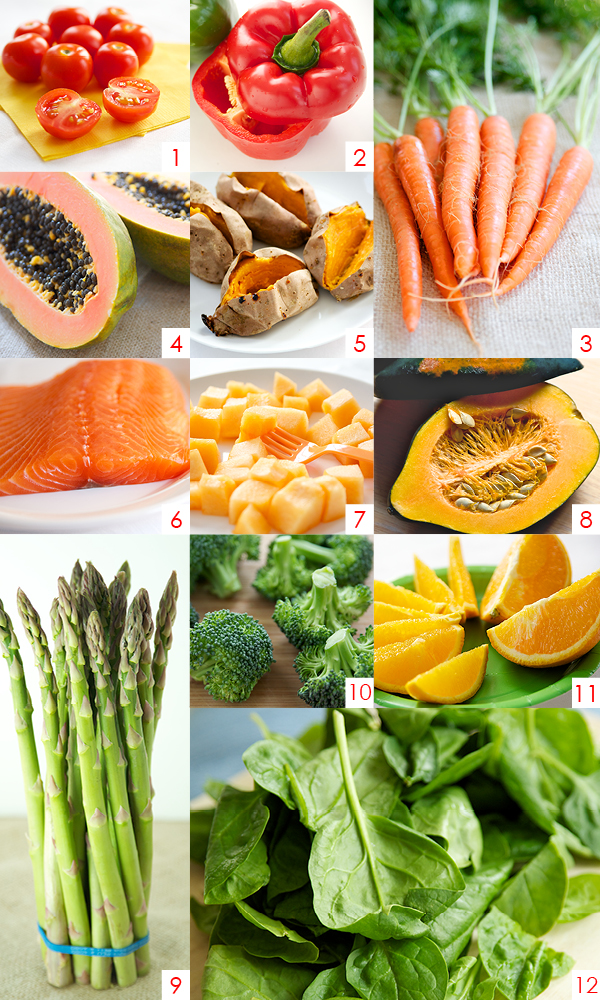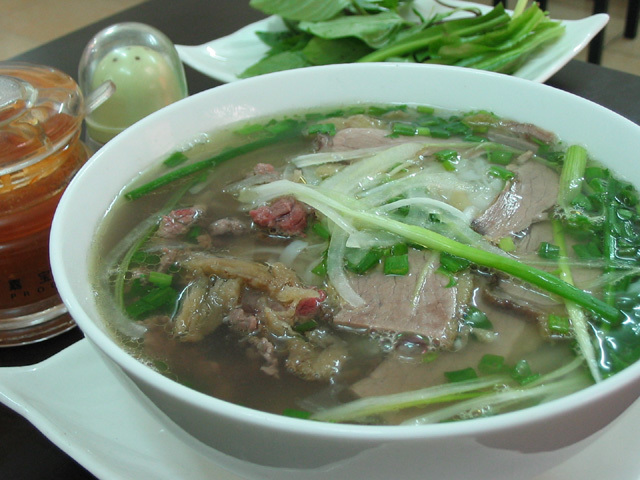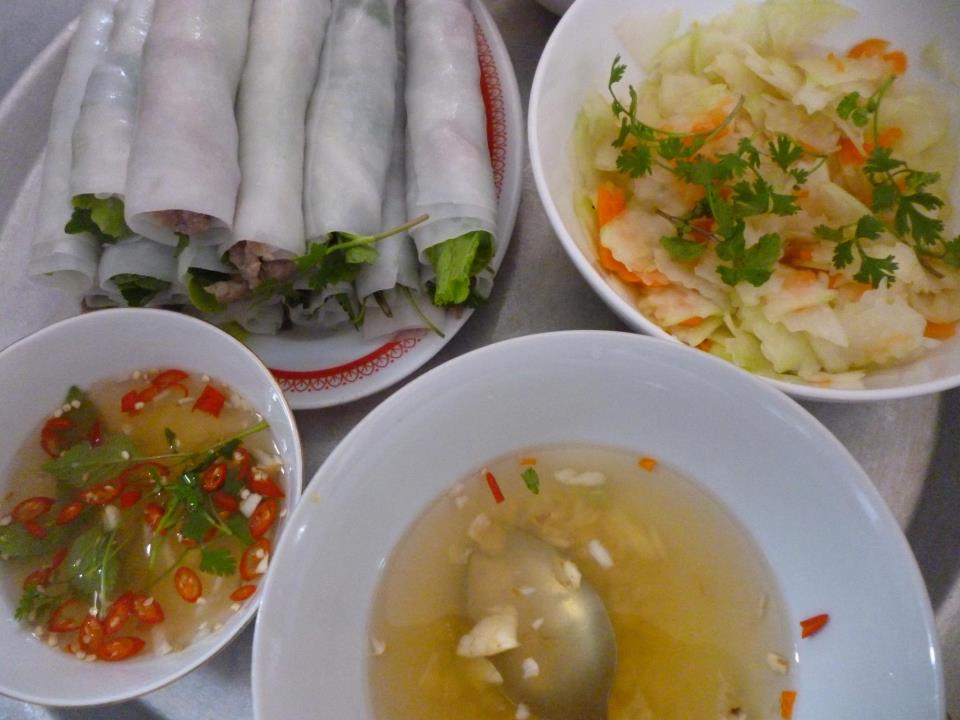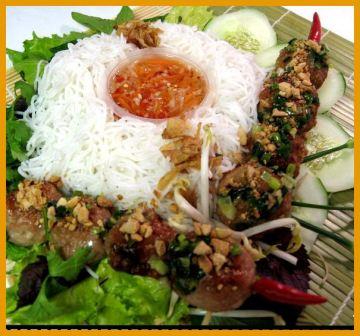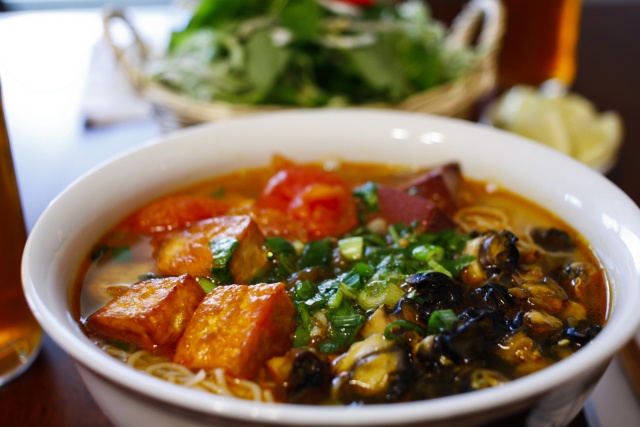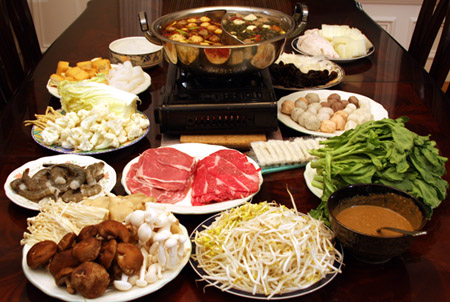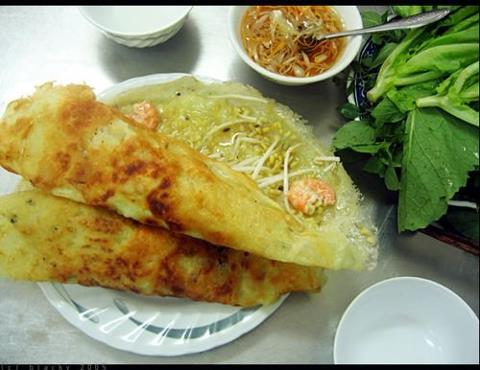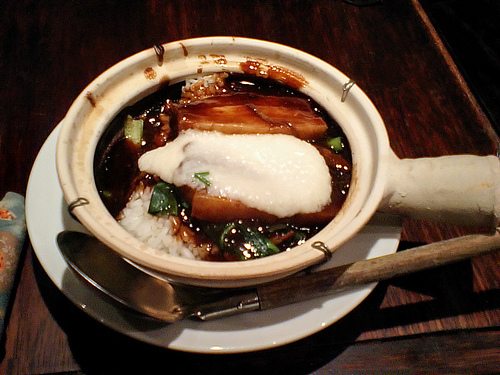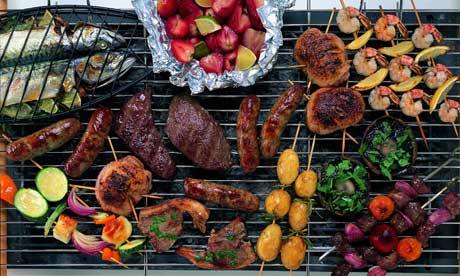Cultural traditions and cuisine of Vietnam is very rich and diverse, with bold ethnic identity. Some typical dishes as:
1. Pho (noodle soup)
There are many kind call it beef noodle soup, chicken noodle soup… You can have a bowl of noodle soup everywhere in Vietnam, but it is almost famous in Hanoi. From the garnish tray, add a squeeze of lime juice. Add beansprouts to the soup, and a dash of chilli sauce and fish sauce. Lastly, sprinkle it with coriander leaves, or mint leaves, or basil. Or all of them. With your chopsticks, thrust deeply to the bottom of the bowl. Lift the noodles above the surface and let the dressings you’ve added subsume into the body of the work. And beef noodle soup is called “pho bo”, while the chicken is “pho ga”.
2. Mon cuon (Rice rolls)
Rice rolls are produced everywhere in Vietnam, with the most well-known being goi cuon, but the variety that are made in Hanoi, banh cuon, have their own special characteristics. The wrappings of banh cuon are as thin as a sheet of paper, appearing as edible alabaster, soft yet offering something to the teeth. Ingredients may include grilled pork, fried bean curd, or vegetables. If you’re really lucky, they’ll add a drop of coleopterous essence (a highly aromatic secretion from the gland of a type of beetle).
Northern specialties
The basic tenets of the north’s cookery are more closely aligned with China than that of other local regions. Fewer spices are available than in the south, but the people couldn’t do without black pepper. They use a superior grade that is mild, yet intensely aromatic, and with a sweetness that is unique to this land. Equally important are the sweet and pungent herbs – basil, mint, coriander, spring onions, and several other tasty leaves.
3. Bun cha
Bun cha is pressed pork served on a bed on of cold rice noodles and dressed with a few herbs. The meat is always cut from a piece of well-marbled pork. It is marinated in a mixture of sweet, hot, sour and salty, and the resulting product tastes like none of its constituent flavours, yet more than the sum of its parts.
4. Snail dishes
In Hanoi there is a type of snail living in ponds and lakes that grows to the size of a golfball, has a streaked colour, and, while chewy, is very tasty. They are called ‘oc‘. Bun oc are boiled snails dipped in nuoc cham , placed in a bowl of rice vermicelli and snail consommé poured over. You can also get bun oc in many seafood restaurants. Oc ngoi are minced snails mixed with onion, garlic and mushroom; rolled in ginger leaves and stuffed in the shell of the snail; then stewed. Pull the ginger leaf out and the rest comes along. Oc hap bia are snails are steamed in beer. Try also oc xao ca vo (shelled stir-fried snails), oc cuon cha (rolled snail), bun oc kho (dried noodle and snails).
5. Lau (Hot pot)
The lau (hot pot) comes from China. It is a turban-shaped pan containing stock in the middle of which is a charcoal stove (now alcohol fuel is used). The stock is kept simmering throughout the meal. The lau is placed in the middle of the table, around which is a variety of foods, including rice vermicelli, pig’s heart, liver and kidneys, goat meat, eel, onion and vegetables. The less adventurous might opt for shellfish, river fish or chicken. Put as much food as you’d like to eat into the pot, give it a stir, and in about five minutes you’re ready for dinner. Keep replenishing the pot as you go. It’s rather like fondue, and just as convivial and fun. Depending on the ingredients used, it might be called lau de (goat meat), lau luon (eel meat) or lau thap cam (with many different kinds of meat).
Southern specialties
The south grows a greater variety of tropical and temperate fruits and vegetables, and more varieties of spice. Southerners also use more sugar in their recipes, even the savoury ones. Dining in the south is very much a hands-on experience. You will be presented with a plate of fresh lettuce and herbs. Take a little of the cooked food and place it in the centre of a lettuce leaf, add some of the herbs, and wrap the lettuce around the food and dip it into whatever sauce is close at hand.
6. Bánh xèo
Bánh xèo is a large crepe filled with goodies. The Vietnamese make it with rice flour and coconut milk, and fill it with meat and shellfish, as well as vegetables. Bánh xèo is often referred to in English as a Vietnamese ‘pancake’. We think this is an unsatisfactory translation, but there seems to be nothing we can do about it.
7. Claypot (noi dat)
Claypot cookery is very southern, and very satisfying. Claypots are usually small, often unglazed, with a lid, and look little different from a flowerpot with a lid. They were originally used by farmers and fishermen who had little to cook, few pots to cook in, and little fuel for the fire.
8. Barbecue
Bake sidewalk just rich and cheap food, both convenient. Across many streets, many alleys around, barbeque smoke spiraling up and fragrant comfortable on the glowing charcoal. The sidewalk barbeque is also different. It depends on the skill of seasoned master. Most of them are coated with synthetic spices such as sugar, pepper, chili, fish sauce … on meat before grilling. When baking is applied spreads the butter, oil or baked goods should look pretty cool.
9. Fresh Beer
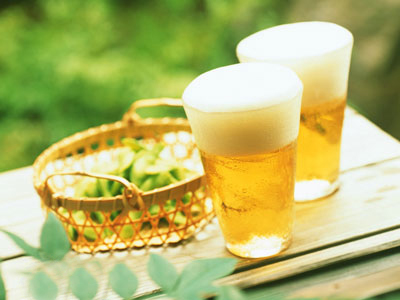
Bia Hoi means simply “fresh beer”. It is a type of draft beer popular and available throughout Vietnam. It is mostly to be found in small bars and on street corners. And it’s cheap, about 6,000 Dong.
